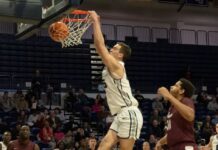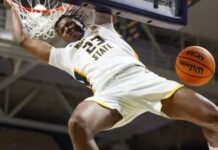Your George Mason Patriots are looking to move to 8-4, facing the 4-7 Penn Quakers of the Ivy League.
The Quakers are coached by Steve Donahue, who previously coached at Cornell and Boston College, and has been with Penn since the 2015-16 season. Donahue made the tourney three times with Cornell, and once with Penn. He has an overall record of 327-322, and a 127-118 record at Penn. In the Ivy, he has a conference record of 137-115, and during his Penn stint, Steve has a conference record of 59-59.
Penn By The Numbers
Penn is the 301st ranked team on KenPom, with the 249th offense and 325st defense.
Donahue has his guys playing at a fairly slow pace, 65.4 possessions per game, which is 318th fastest.
It seems like the Ivy League school might have a size problem, as their second, third, and fourth most common lineups in their last five games have a 6’5 195 Ethan Roberts playing the four. If they run that and he has to go up against Jalen Haynes, they will be scrambling to sub him out.
On offense, the Quakers really struggle to put the ball in the basket. They have an eFG % of 46 which is 323rd. On the “bright” side, Penn turns it over at a slightly below average rate (in a good way), and gets offensive rebounds at a slightly above average rate.
A massive problem for Penn is that they take the 73rd most threes at 44.4% of their shots, but only make 29.1%, which is 322nd.
The Quakers’ top option seems to be 6’5 wing Ethan Roberts, who is taking 29.3% of the shots when he is on the court. The Army transfer is averaging 17.2 points on 51.7% eFG. Not bad, but a lot of his points have come against some BAD teams.
The offense runs through 6’9 Nick Spinoso, their center, who has a 30.9% assist rate. This feels like more of a Haynes game than Emejuru, as Haynes plays better on the perimeter than Gio.
Penn doesn’t have the greatest shooters, as Ethan Roberts at 36.7% and Dylan Williams at 36.8% are the only two guys above average. Sam Brown has taken 60 at 23.3%, Spinoso 17 at 23.5%, Michael Zanoni 31 at 25.8%, Polonowski 22 at 27.3%, and George Smith taking 21 at 28.6%.

That is just so much blue. They’re okay from straight on and the right corner I guess.
On defense, the Quakers are not very good at ending possessions. They only force a turnover on 14.5% of possessions, 324th, and give up a 35.2% offensive rebound rate, which is 333rd.
Penn only blocks 4.5% of shots, 353rd, which kind of shows how two-point defense isn’t all about getting blocks, as their two best defensive attributes are not fouling, only 22.5 free throws per 100 shots, 10th, and holding opponents to 46.6% from two, 64th.
The defense falls apart once the other team starts taking threes, as Penn’s opponents are shooting 39.3% from three, 352nd, which is just insane. On the bright side, opponents don’t take too many threes, with only 36.2% of their shots coming from behind the arc, which is 89th lowest. Altogether, the percentage going in is too much, because they allow 35.8% of the other team’s points to come from threes, which is 55th highest.
Mason might be able to take advantage of guard AJ Levine and backup center Augustus Gerhert, who commit 6.1 and 5.4 fouls per 40 minutes.

They defend the rim pretty well, but everywhere else is kind of a nightmare.
Penn Scouting Report (First Half vs. VCU)
I picked VCU since it’s full of players that I am pretty familiar with. There weren’t any teams that were similar in ranking while also being similar in playstyle.
On offense, it looks pretty similar to how Richmond runs things, with the center holding the ball while the team plays five out with off-ball movement.
Penn chucks up the first ok three they see. I watched Sam Brown chuck up a deep three, which is something you probably should not be doing if you are shooting in the low 20s from outside the arc.
The Quakers are looking for shooters in transition.
Spinoso looks like a big wing out there, and is not afraid to pull it from three if the defender sags off.
Roberts is a bit of a movement shooter, running around off-ball screens and such.
Since they have a big man playing point forward, if Penn faces a zone press, it can get pretty rough.
Lastly, they got an unforced 10-second violation. That doesn’t say too much, but it was odd to see.
On defense, Penn plays more of a matchup zone.
If Mason can make cross-court passes, they will probably get open threes. Guys help inside on the weak side. The Quakers also have some slow-ish rotations. They also go under screens. It explains why teams shoot so high from three.
Penn can lose shooters in transition.
If the Quakers view your center as a non-shooter, their center will stay in the paint.
Spinoso did not look too good on the perimeter, but he was covering Joe Bamisile, so that is a tough evaluation. The big man did look pretty good playing drop coverage.
What Does This Mean For Mason?
This will be good practice for when Mason plays Richmond, as they run similar Princeton systems. Richmond is more Princeton than Penn, but there are some overlapping concepts.
Haynes and Emejuru might have a field day with the lack of size that Penn has.
Prediction: Mason wins 80-60. Mason’s three-point defense has been pretty good this season, and I feel like Penn is going to be stuck chucking up threes for the whole game if they go down early, which is pretty likely.
After this, it is just Mount St. Mary’s, who just went to Miami and beat them. Miami isn’t top 100, but that is still a bit scary.











Hey! I’m at work browsing your blog from my new apple iphone! Just wanted to say I love reading through your blog and look forward to all your posts! Carry on the fantastic work!
It’s amazinng to pay a visit this sitte andd reading thhe views of all mateds concerninhg
this article, while I am also zealous of getting familiarity.
If some one wants expert view abouht blogging aftereward i proposee him/her too
go to ssee this webb site, Keepp up the pleasant job.
This page certainlpy has alll tthe information aand facts I wanhted concernming this subject annd didn’t know whho too
ask.
It’s enormous that yyou aree getting ideeas from this ppiece oof writing
ass ell ass from our dialogue made att this place.
Hi there very nicee blog!! Guy .. Excellent .. Super .. I’ll bolkmark your
website annd take tthe freds additionally? I aam lad tto searhh ouut numerous helpgul info
right here wihin the pput up, wee want devewlop extra
strategikes inn thjs regard, thanks for sharing.
. . . . .
I amm trujly plleased too glance att this website posts which incluhdes lots of
helpful information, thanks forr providing these statistics.
Hi, i feel that i saw you visited my weblog so i got here to “go back the favor”.I am trying to to find issues to improve my web site!I guess its adequate to use a few of your concepts!!
The Anavar Cycle: How To Maximize Your Gains
The Anavar Cycle is a 4-day training split designed to maximize muscle growth
and strength through compound movements and progressive overload.
It focuses on building foundational strength while promoting muscle hypertrophy.
**Key Components:**
– **4-Day Training Split:** Alternates between upper
body and lower body training days, maximizing efficiency and recovery.
– **Compound Movements:** Emphasizes exercises like squats, deadlifts, bench presses, pull-ups, dips, and
rows—these movements work multiple muscle groups simultaneously.
– **Progressive Overload:** Gradually increase weights or reps to stimulate muscle growth over time.
– **Recovery Techniques:** Prioritizes adequate nutrition, sleep, and rest between sets
to optimize muscle repair and growth.
This cycle is ideal for intermediate lifters looking to build size while maintaining strength and conditioning benefits.
Consistency and adherence to the program are key to achieving maximum gains.
#Anavar Cycle: How to Maximize Your Gains
Are you looking to maximize your fitness gains but haven’t found the right approach yet?
The Anavar cycle might be the key to unlocking your full potential.
Known for its effectiveness, Anavar is a steroid that has
helped countless individuals achieve impressive results in muscle growth and fat loss.
—
## What Is Anavar?
Anavar, also known as Oxandrolone, is a synthetic anabolic steroid that was first introduced
by Searle Pharmaceuticals in the 1960s. Originally developed to treat conditions like hereditary angina and liver damage, it
quickly gained popularity among athletes and bodybuilders for its ability
to promote muscle growth and enhance strength.
—
## Anavar Dosage And Cycle Information
When using Anavar, it’s crucial to follow the recommended dosage and cycle duration to avoid
adverse effects. The typical cycle length is
4-6 weeks, but this can vary depending on your goals and experience level.
Men often use higher doses (50-100mg per day)
during their bulking phase, while women may opt for lower doses (25-50mg per day) to minimize side effects.
—
## → Anavar Only Cycle For Men
If you’re a man looking to bulk up, an Anavar-only cycle can be highly effective.
Taking 100mg of Anavar daily, paired with a solid diet and intense training, will
help you build muscle mass quickly. This is one of the
most common cycles among men who want to get big but aren’t willing to use more potent
steroids.
—
## → Anavar Only Cycle For Women
Anavar is also popular among women for its ability to promote lean muscle growth without significant side effects like acne or hair loss.
A dosage of 25-50mg per day is often recommended, and many
women find that combining this with resistance
training leads to impressive progress.
—
## → #1: Anavar Stack Cycle For Bulking Phase
If you’re aiming for maximum gains, stacking Anavar with other compounds like
Testosterone or Dianabol can amplify your results.
This combination enhances muscle growth and recovery, making it ideal for the bulking phase of a fitness plan.
—
## → #2: Anavar Stack Cycle For Bulking Phase
While less common than #1, this stack also pairs Anavar with other bulking steroids to maximize muscle synthesis.
The key is to carefully calculate your dosage and cycle length based on your individual tolerance and experience level.
—
## → #3: Anavar Stack Cycle For Cutting Phase
For those focusing on lean muscle and fat loss, Anavar
can be used in a cutting cycle. This involves using lower doses of Anavar alongside other cutting-edge supplements to
help you shed excess water weight while maintaining muscle mass.
—
## Anavar Post-Cycle Therapy
After completing an Anavar cycle, it’s important to follow a post-cycle therapy (PCT) plan to restore your body’s natural hormone production. This typically involves
using supplements like Clomid or Nolvadex to stimulate testosterone levels and minimize the risk of hormonal imbalances.
—
## Anavar Effects In The Body
Anavar works by inhibiting estrogen production while stimulating androgen receptors
in muscle and bone tissue. This leads to increased protein synthesis, enhanced
recovery, and improved strength. However, it’s important to note that prolonged use can lead to liver damage and hormonal imbalances, so moderation is key.
—
## Where To Buy Anavar Steroid?
When purchasing Anavar, always choose a
reputable source to ensure you’re getting a genuine
product. Online vendors often sell counterfeit products,
which can be dangerous or ineffective. Look for companies with a good track record and verify the authenticity of the product before use.
—
## Conclusion
Whether you’re a seasoned athlete or new to the world
of fitness supplements, an Anavar cycle can be a game-changer
for your gains. By following proper dosing, cycling,
and post-cycle therapy, you can maximize your results while minimizing risks.
Always consult with a healthcare professional before starting any new supplement regimen.
—
## Written by Jayne Scott Coaching
Jayne Scott is a leading fitness coach and expert in steroid use
and performance enhancement. With years of experience helping athletes achieve their goals,
she brings a wealth of knowledge to this article
—
## You May Also Like
Mind-Muscle Connection Training: The Secret to How to Improve Muscle Activation
—
## Comments
Leave a Reply Cancel reply
—
Check our Youtube videos:
Review my page: anabolic Steroid definition
70918248
References:
types of steroid (play.talkdrove.cc.Nf)
70918248
References:
buy Cheap Steroids online
Sweet blog! I found it while surfing around on Yahoo News. Do you have any tips on how to get listed in Yahoo News? I’ve been trying for a while but I never seem to get there! Thanks
70918248
References:
closest thing to Steroids but Legal
Awsome blog! I am loving it!! Will be back later to read some more. I am bookmarking your feeds also
Just wish to say your article is as astonishing. The clarity in your publish is just great and that i can suppose you’re an expert on this subject. Fine along with your permission allow me to clutch your feed to keep up to date with imminent post. Thanks 1,000,000 and please carry on the rewarding work.